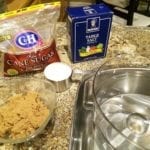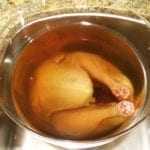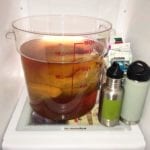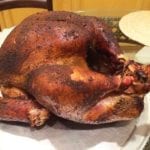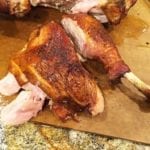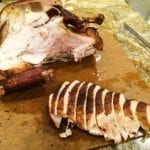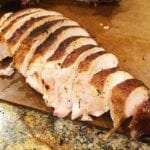Summary
- Buy a 12-14 pound Butterball self-basting turkey.
- Brine for 8-12 hours or overnight.
- Apply your favorite rub inside and out.
- Smoke at 325-350°F until 160-165°F in the breast, 170-175°F in the thigh, approximately 2-1/2 to 3 hours.
- Let rest for 20 minutes before carving. Alternatively, wrap tightly in several layers of foil, place breast-side down in an empty cooler, and hold for 90-120 minutes before carving.
- Collect the pan drippings for making gravy.
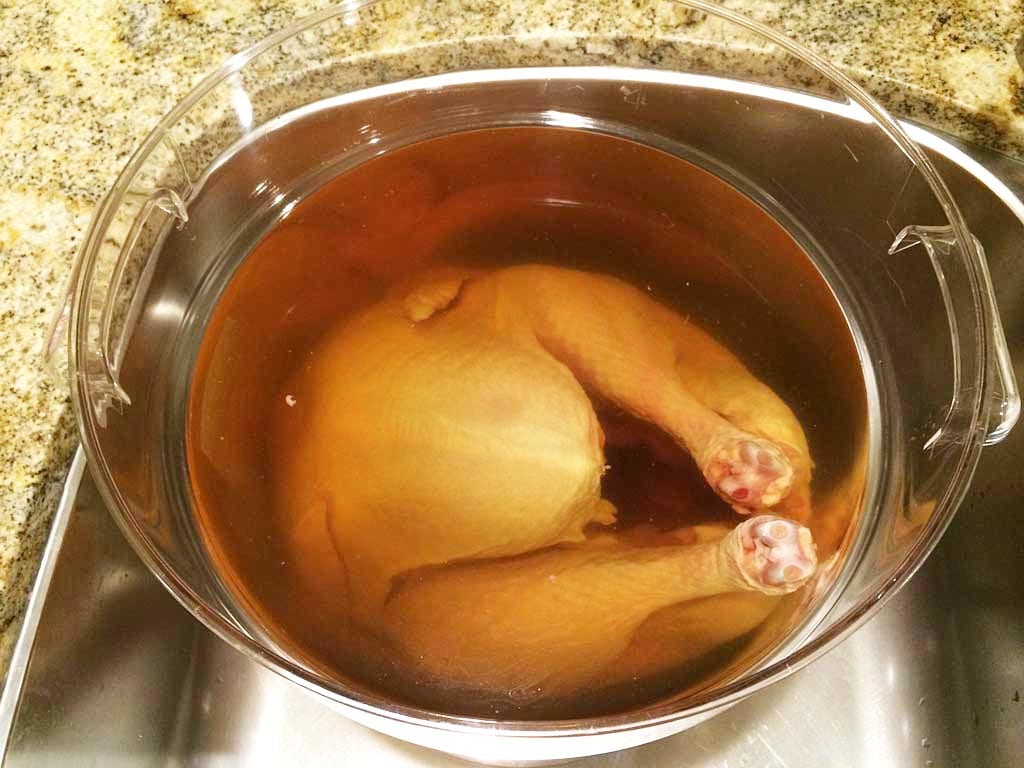
One of the common questions discussed in the Turkey Talk Forum at The Virtual Weber Bulletin Board is whether you can brine an injected, self-basting turkey like the popular Butterball brand turkey. I’ve always advocated brining a natural turkey so that you have total control over the flavors being adding to the meat. However, there are cases where people want to try brining an enhanced turkey because it’s the most affordable option or because that’s all they can find at their local supermarket.
As it turns out, you can successfully brine an injected turkey as long as you take care to not brine it too long or use too strong a brine solution so the meat doesn’t become too salty.
Here are some photos I took on December 14, 2014 when I brined and smoked this Butterball turkey.
Select & Prepare The Turkey
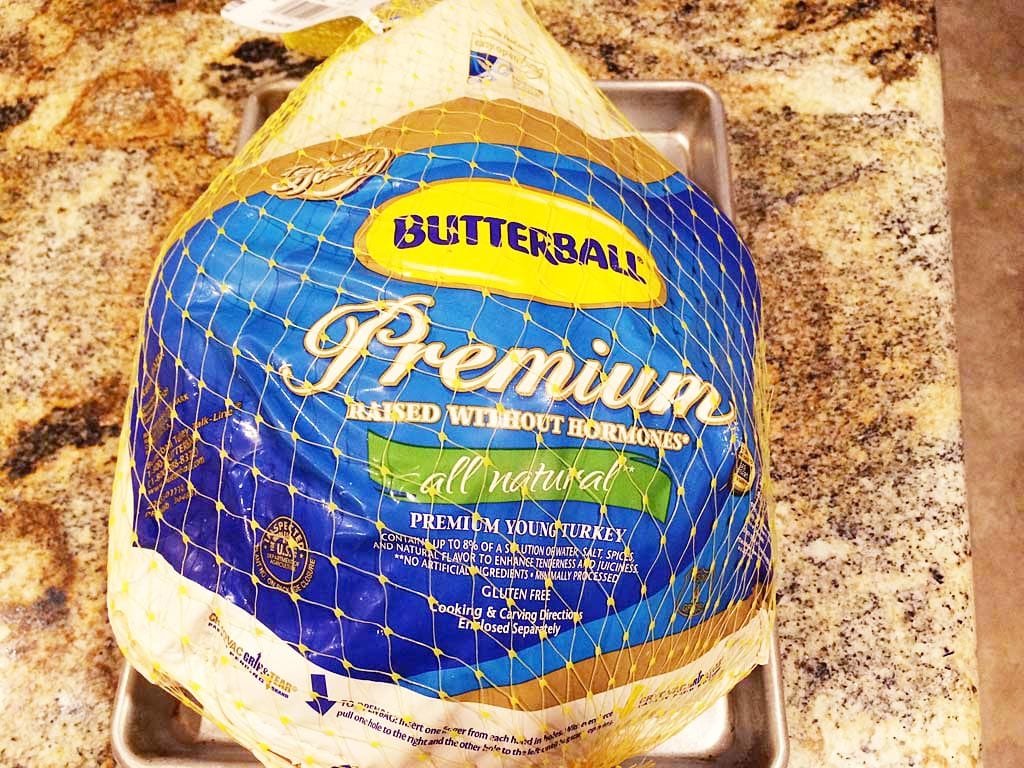
Choose a 12-14 pound self-basting Butterball brand or equivalent store brand turkey. Thaw according to the package directions. Remove and discard any leg restraint, then remove the giblets from the neck cavity and the neck from the body cavity. Trim away large areas of fat or excess skin around the body cavity, rinse thoroughly inside and out, and pat dry with paper towels.
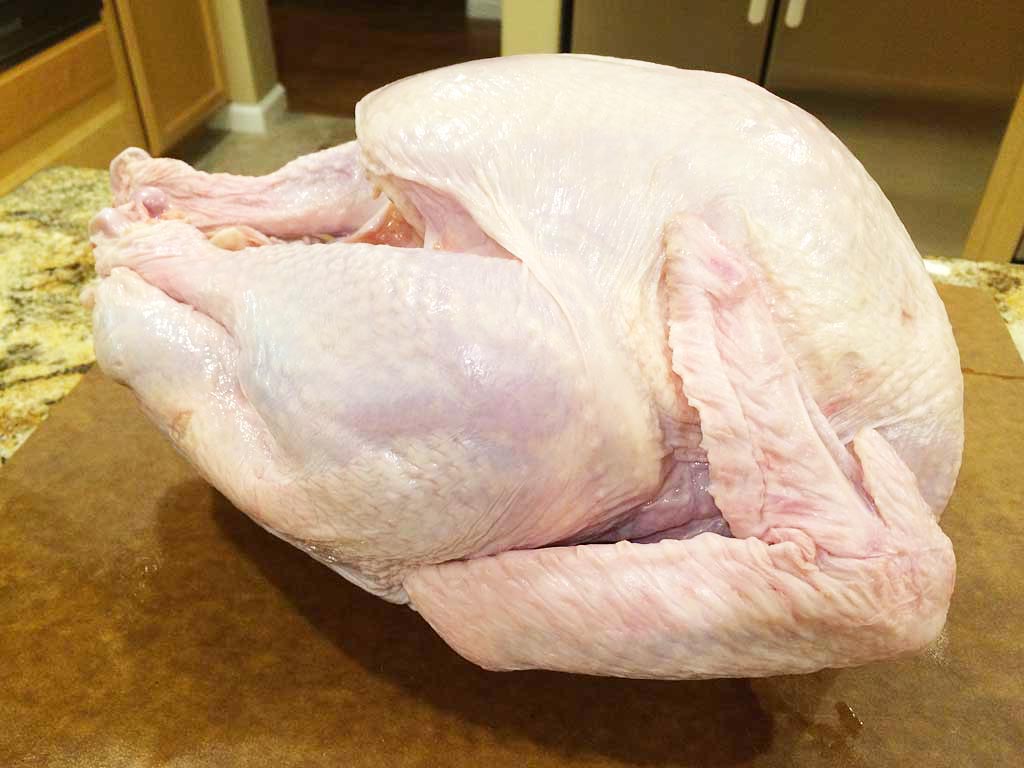
The turkey is now ready for brining.
These photos show the 13.04 pound Butterball Premium frozen turkey I cooked for this recipe, a common turkey that you’ll find at supermarkets all over the United States.
Brine The Turkey
In preparation for brining:
- Find a non-reactive container large enough to hold the turkey.
- Make sure the container will fit in your refrigerator.
See All About Brining and Food Grade Plastic Containers For Brining for information about selecting an appropriate container, including alternatives like coolers or turkey roasting bags inside non-food safe containers. These pictures show an 18-quart polycarbonate food service container that I purchased at a restaurant supply store.
Here’s the recipe for the simple brine solution I used for this turkey.
Basic Brine For Turkey
- 2 gallons water
- 1 cup table salt
- 1 cup brown sugar
Substitute 1.5 cups Morton kosher salt or 2 cups Diamond Crystal kosher salt for table salt.
Combine ingredients and stir to dissolve salt and sugar.
Put the turkey in the brine solution. Place a heavy plate or bowl on top to keep the bird submerged, if necessary.
Brine the turkey for 8-12 hours or overnight. Since brining does not preserve meat, the turkey and the brine solution must be kept below 40°F throughout the entire brining process.
Fire The WSM
Fire-up the cooker using the Standard Method—one full Weber chimney starter of hot Kingsford Charcoal Briquets in the charcoal bowl, followed by another full chimney of unlit Kingsford, allowing all coals to become fully lit before cooking.
Foil The Water Pan
Cover the inside and outside of the water pan with wide, heavy duty aluminum foil. Place the pan inside the cooker, but leave it empty.
Rub The Turkey
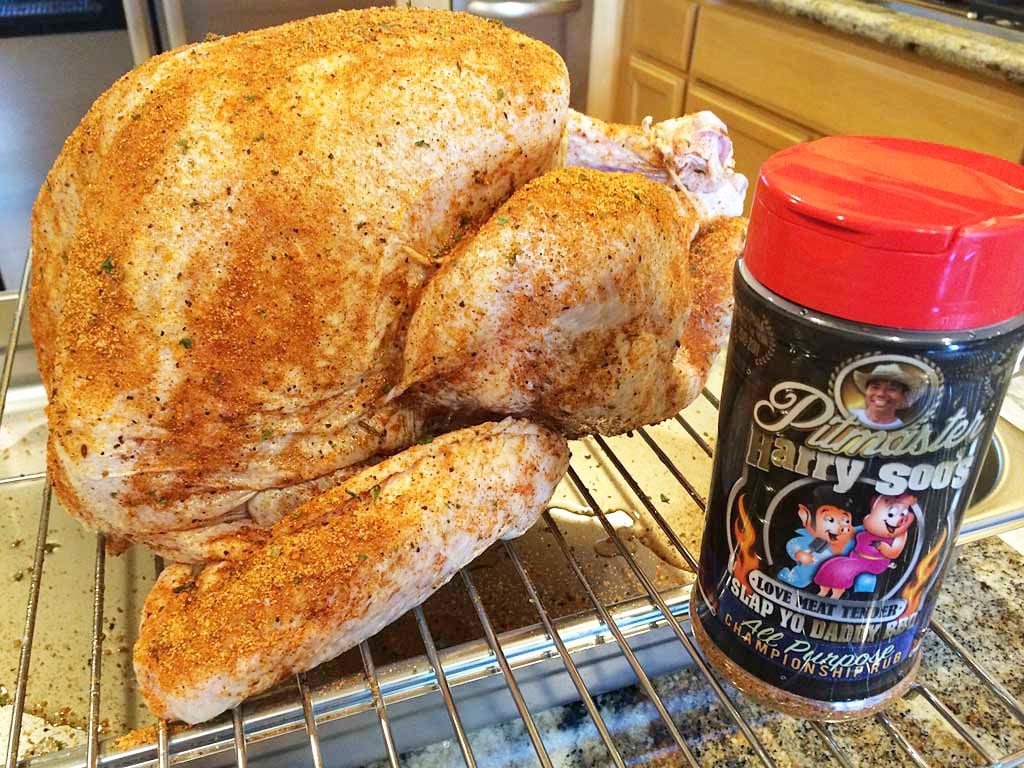
Remove the turkey from the brine around the same time you start firing-up the cooker. Pat dry with paper towels, then apply a very thin coat of vegetable oil to the turkey skin. Sprinkle with your favorite rub inside and out. Let the turkey stand at room temperature until ready to go into the cooker.
I used Slap Yo’ Daddy BBQ “Love Meat Tender” All-Purpose Championship Rub on this turkey. You can make your own version using this recipe from Harry Soo.
SYD All-Purpose Rub
- 1 Tablespoon Lawry’s Seasoned Salt
- 1 Tablespoon granulated sugar
- 1 Tablespoon McCormick Grill Mates Montreal Steak Seasoning
- 1-1/2 teaspoons mild chili powder
- 1-1/2 teaspoons paprika
- 1-1/2 teaspoons granulated garlic
- 1/4 to 1/2 teaspoon cayenne pepper
Combine ingredients thoroughly.
For better presentation, tie the ends of the drumsticks together using kitchen twine so they don’t splay out into a funny shape during cooking. There’s no need for any elaborate trussing. Also, fold the wing tips under the turkey.
Smoke The Turkey
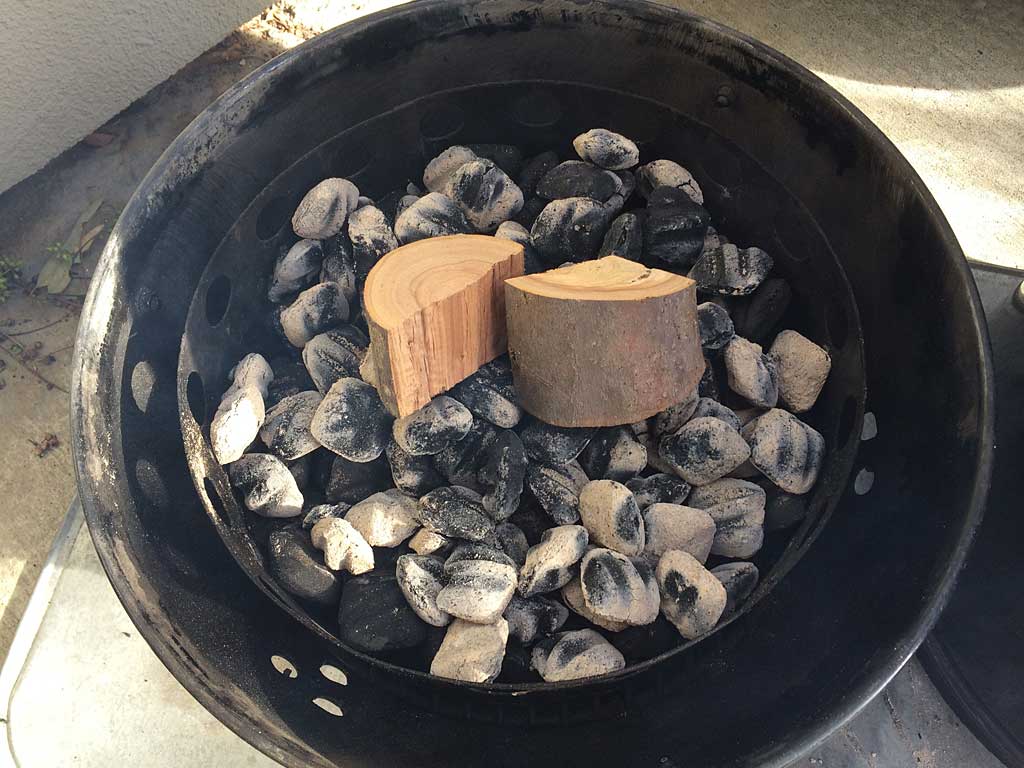
When all the coals are covered with gray ash, place 2 fist-sized chunks of dry apple wood or other mild smoke wood on the coals.
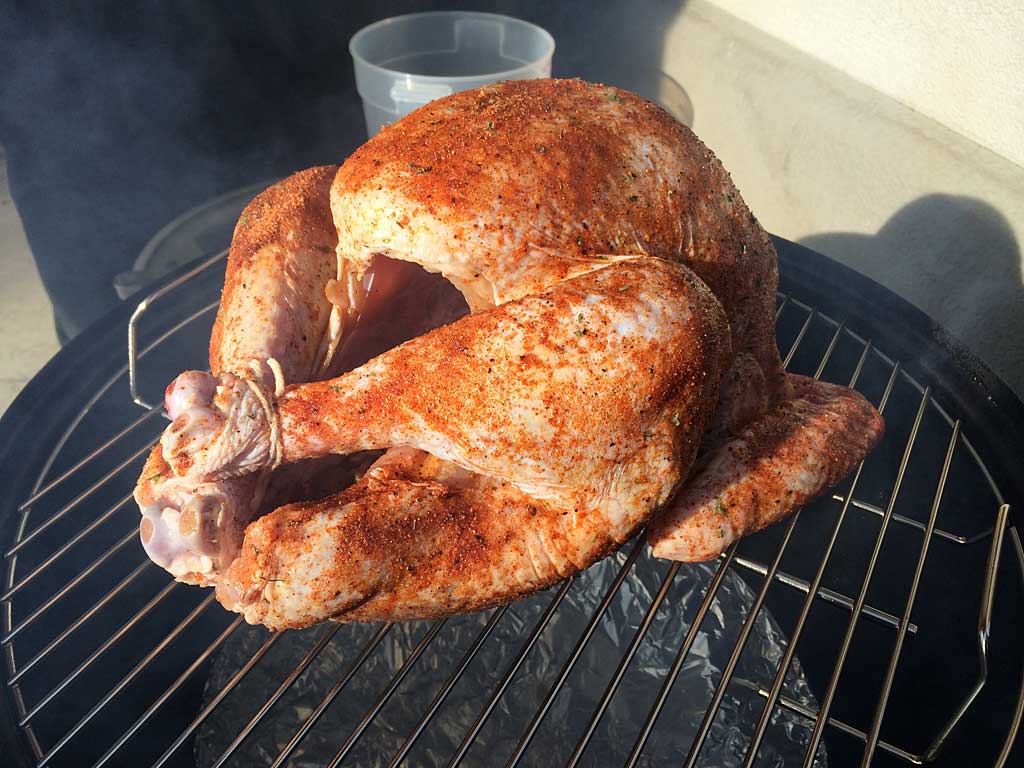
Assemble the cooker and place the turkey breast-side up on the top grate. Set the three bottom vents to 50% open. Open the top vent fully and leave it that way throughout the entire cook.
Adjust the bottom vents as necessary throughout the cooking process to maintain a temperature of 325-350°F measured at the lid.
Cook the turkey until it measures 160-165°F in the breast, 170-175°F in the thigh, using an instant-read thermometer. Cooking time is approximately 2-1/2 to 3 hours.
There’s no need to baste or rotate the turkey during the cooking process.
I smoked this turkey on a very windy day and had only a partial wind screen to protect the WSM. As a result, I had difficulty getting the cooker above 300°F. Still, the turkey was finished in 3 hours to just over the target internal temperature.
Here’s how the cooker temperatures and vent settings went during my cook:
| Time | Lid Temp | Meat Temp | Vent 1 % | Vent 2 % | Vent 3 % |
| 2:00 pm | – | – | 100 | 100 | 100 |
| 2:30 pm | 292 | – | 100 | 100 | 100 |
| 3:00 pm | 302 | – | 100 | 100 | 100 |
| 3:30 pm | 302 | – | 100 | 100 | 100 |
| 4:00 pm | 305 | – | 100 | 100 | 100 |
| 4:30 pm | 300 | – | 100 | 100 | 100 |
| 5:00 pm | 295 | 170 | 100 | 100 | 100 |
Note that the vent percentages represent the way I set the vents at the time indicated.
Rest Then Carve The Turkey
Remove the turkey from the cooker and let rest for 20 minutes before carving. Do not cover with foil, as this will cause the skin to go soft.
Alternatively, wrap the turkey tightly in several layers of wide, heavy duty aluminum foil, place breast-side down in an empty cooler, and hold for 90-120 minutes before carving.
After the rest, carve the turkey to your liking. See the Turkey Selection & Preparation article for carving tips.
I like to remove the breast as a single piece and then cut into slices across the grain using an electric carving knife as shown in the photo above.
My cooking log notes that this turkey had a dark mahogany color with good moisture, tenderness and flavor without being too salty.
Collecting Pan Drippings For Gravy
There are three common ways to collect pan drippings when smoking a turkey:
- Cook the turkey in a shallow, disposable foil pan.
- Cook the turkey on the top cooking grate. Place an empty foil pan on the bottom grate to catch the drippings.
- Cook the turkey on the top cooking grate. Line the water pan with wide, heavy duty aluminum foil, but suspend the foil 1-1/2″ above the bottom of the pan so it does not touch. This prevents the drippings from burning.
Here’s an example of lining the water pan with foil and catching the drippings:
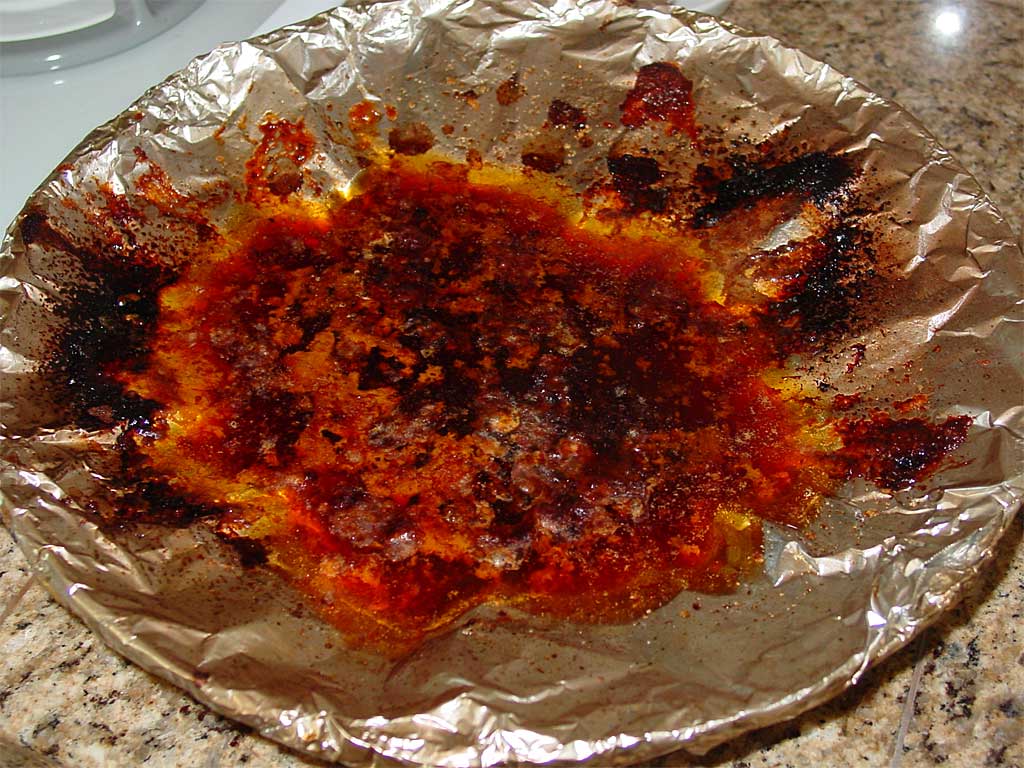 Assuming you don’t over-smoke the turkey, the drippings will be perfect for making gravy—in fact, they’re already seasoned by the salt applied to the turkey.
Assuming you don’t over-smoke the turkey, the drippings will be perfect for making gravy—in fact, they’re already seasoned by the salt applied to the turkey.
As you remove the turkey from the cooker, pour any accumulated juices inside the body cavity into the pan. You can also use the juices left in the bottom of a rimmed baking sheet pan after letting the turkey rest before carving.
You’ll typically end up with about 1-1/2 cups of drippings.
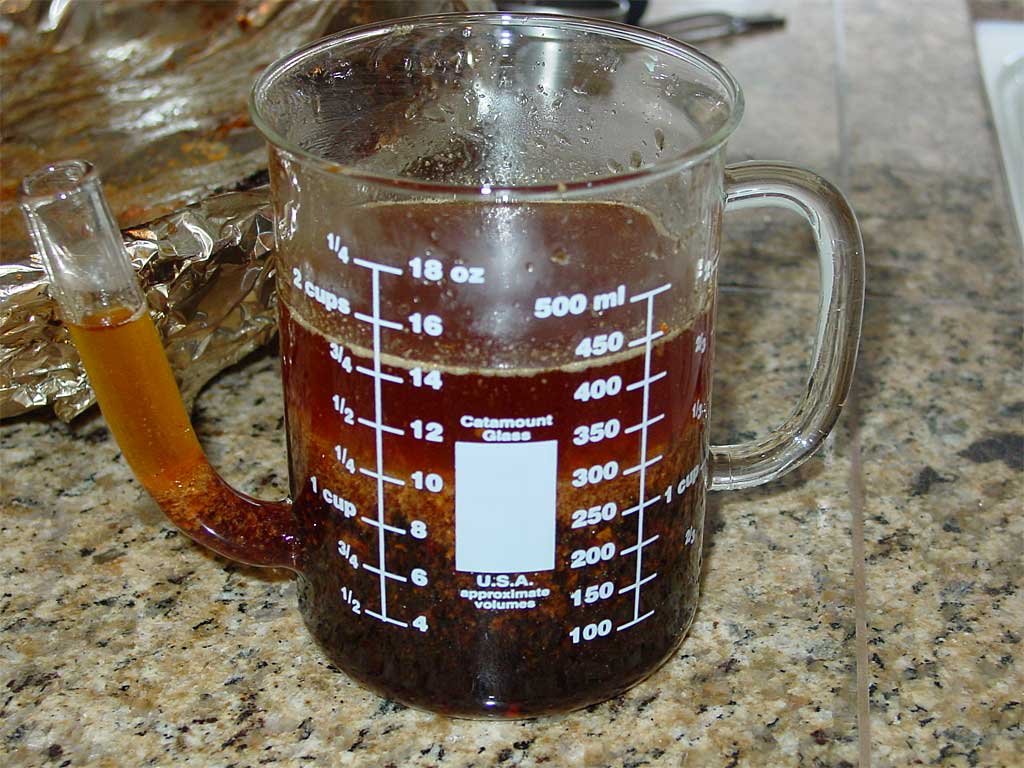
If you don’t have any drippings, make the delicious turkey giblet gravy described on The Virtual Weber Bulletin Board using the giblets, aromatic vegetables, chicken stock, white wine, and seasonings.
-
More Turkey Links On TVWB
- Whole Turkey – Self-Basting
- Whole Turkey – Basic Brine
- Whole Turkey – Apple Brine
- Whole Turkey – Honey Brine
- Whole Turkey – Salted aka Dry Brined
- Butterflied Turkey – Salted
- Turkey Breast – Bone-In
- Turkey Breast – Boneless & Skinless
- Turkey Breast – Central Texas Style
- Giant Texas Turkey Legs: The Easy Way
- Turkey Selection & Preparation
- All About Brining
- All About Dry Brining (Salting) Meat
- Video: Turkey Carving Demo
- Transcript: Turkey Chat With TVWB & Weber’s Kevin Kolman – November 2013
- Countdown to Thanksgiving: 30 Tips For Your Best Thanksgiving Ever
- Turkey Talk Forum At The Virtual Weber Bulletin Board
- Turkey Recipes At The Virtual Weber Bulletin Board
 Don’t Cook Your First Turkey On Thanksgiving Day
Don’t Cook Your First Turkey On Thanksgiving Day
Don’t attempt to cook your first whole turkey on Thanksgiving Day. Who needs the pressure? Instead, cook a practice turkey a week or so before the big day. This way, you’ll be confident in your abilities and in your recipe, and you’ll look like a seasoned pro when you pull the perfect smoked turkey from the WSM and present it to your family and friends.

